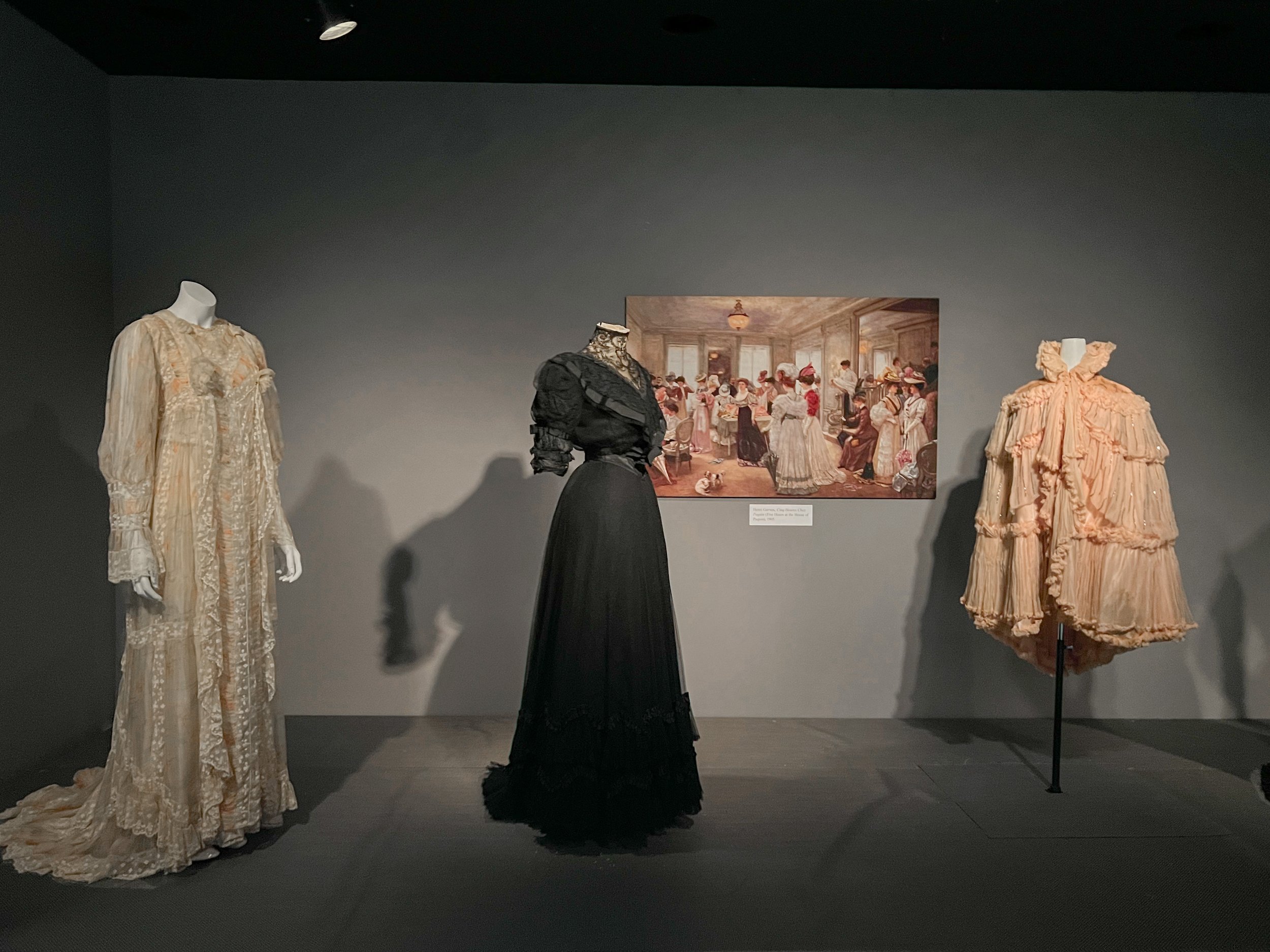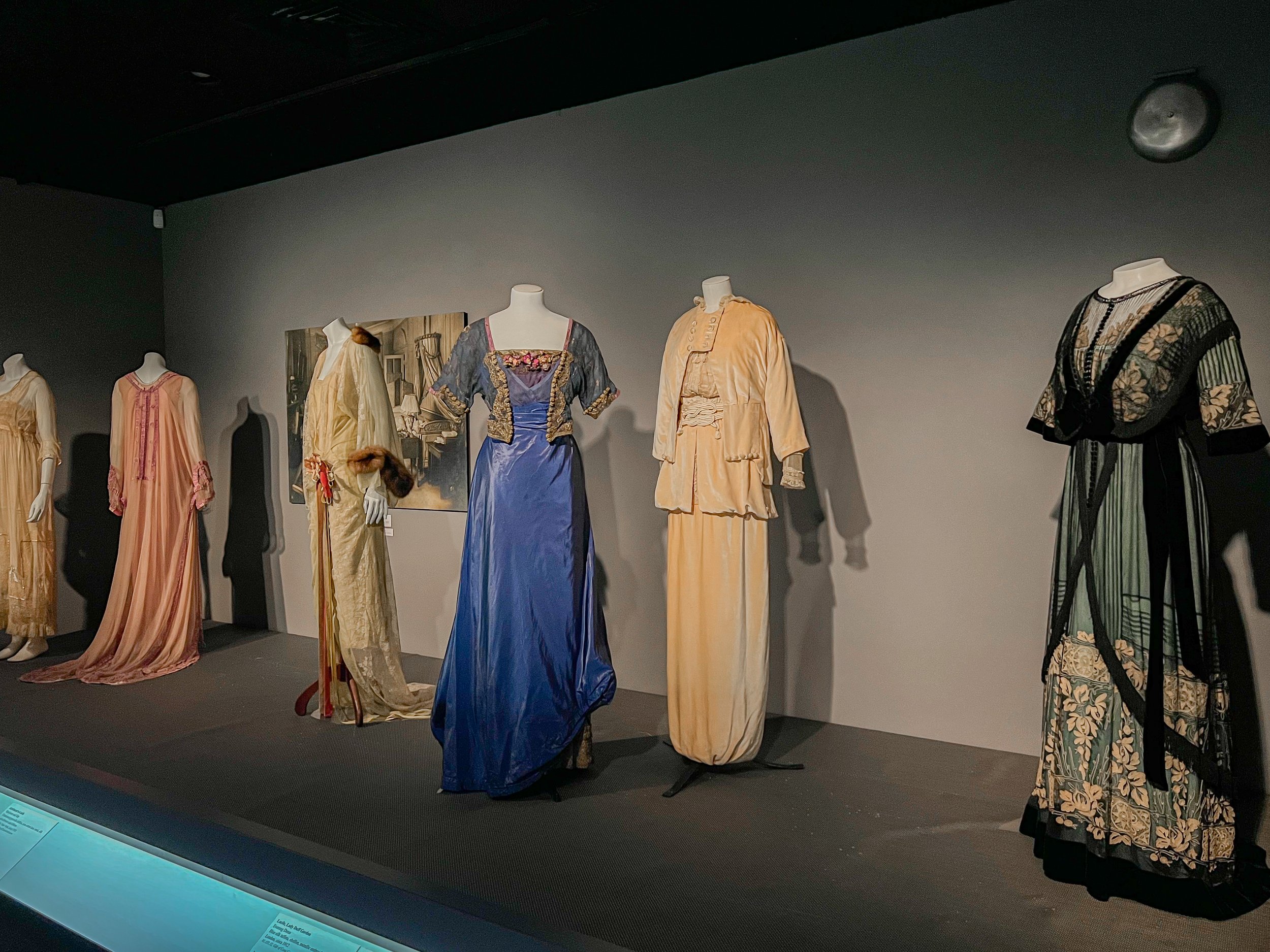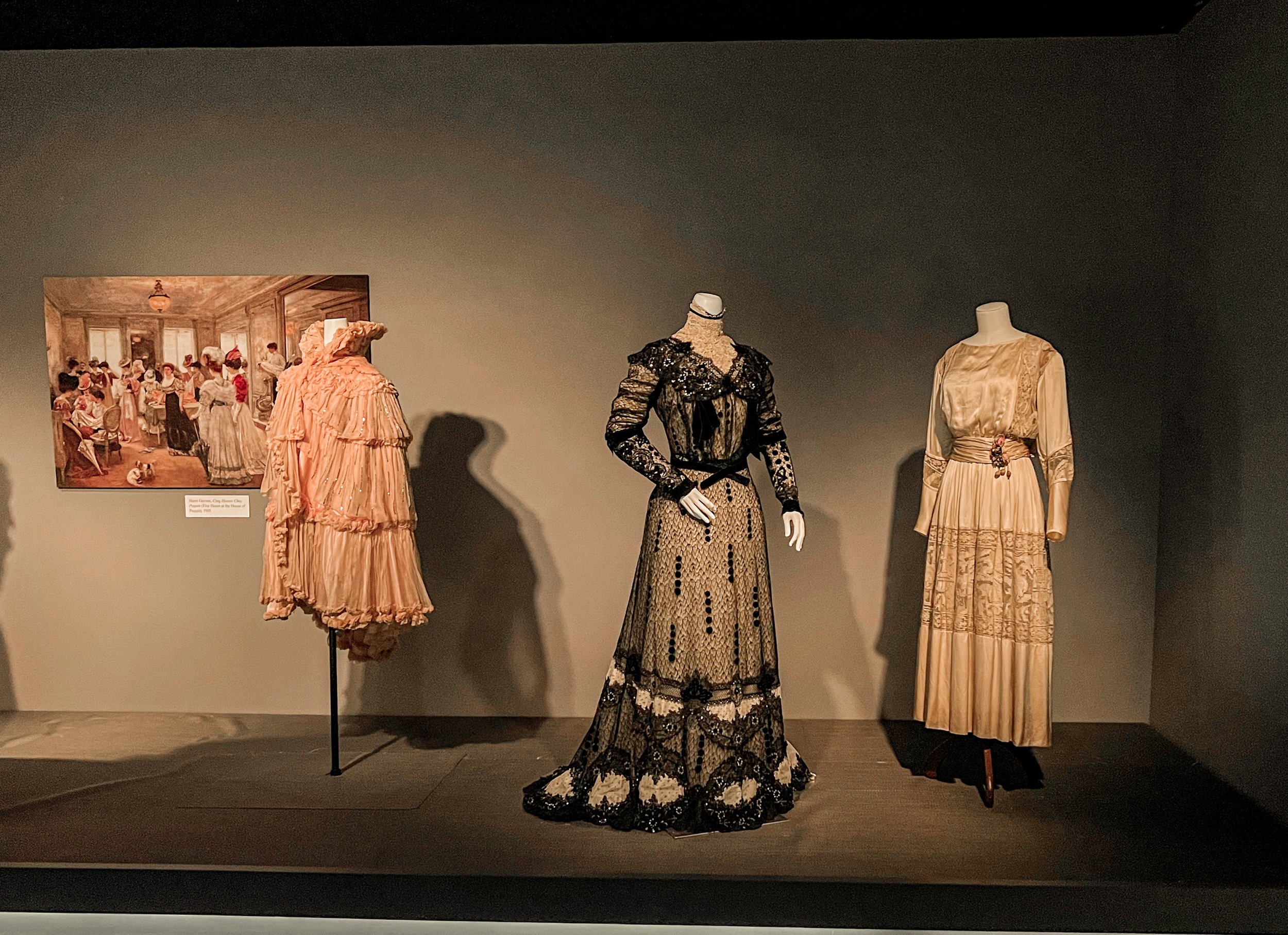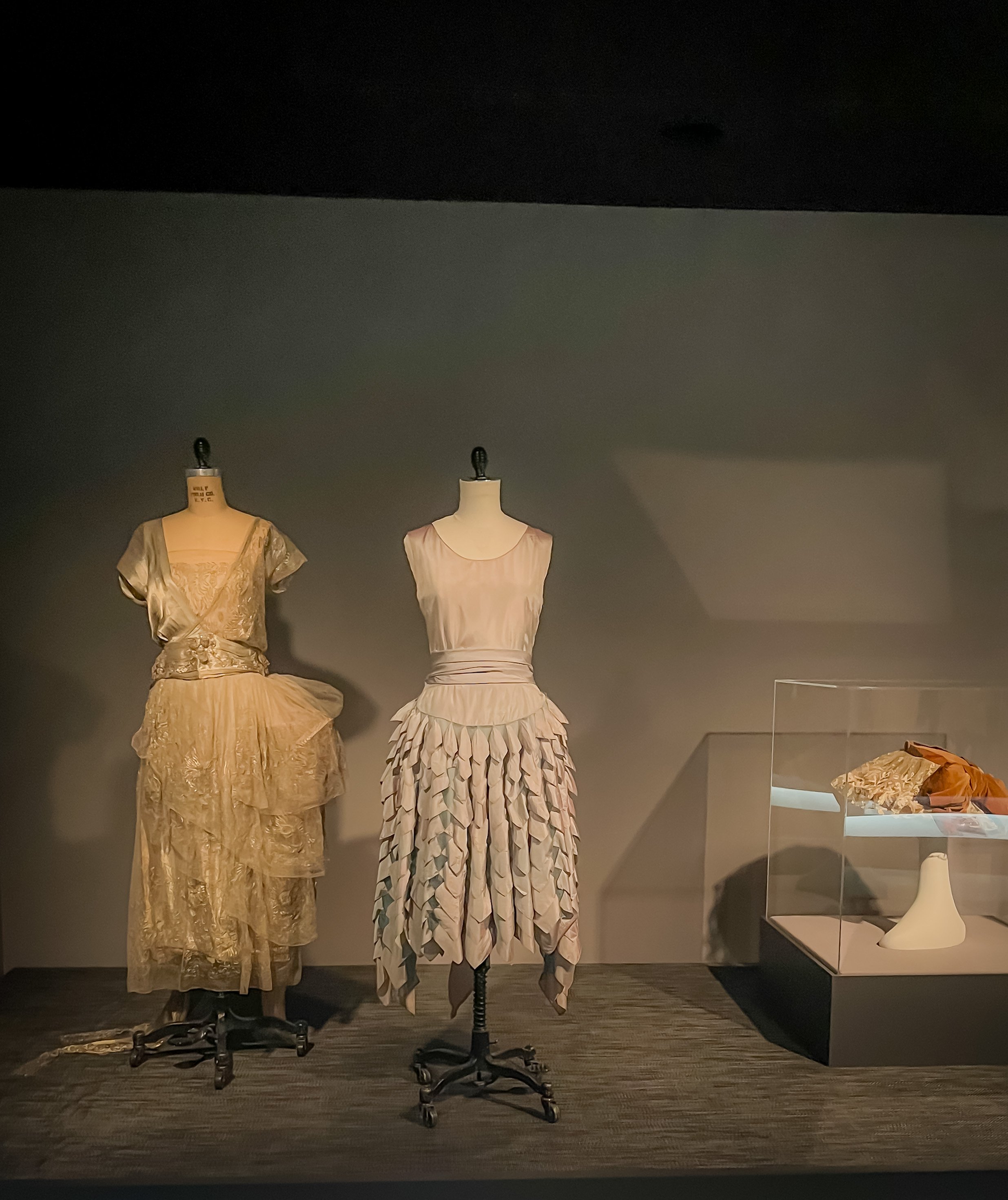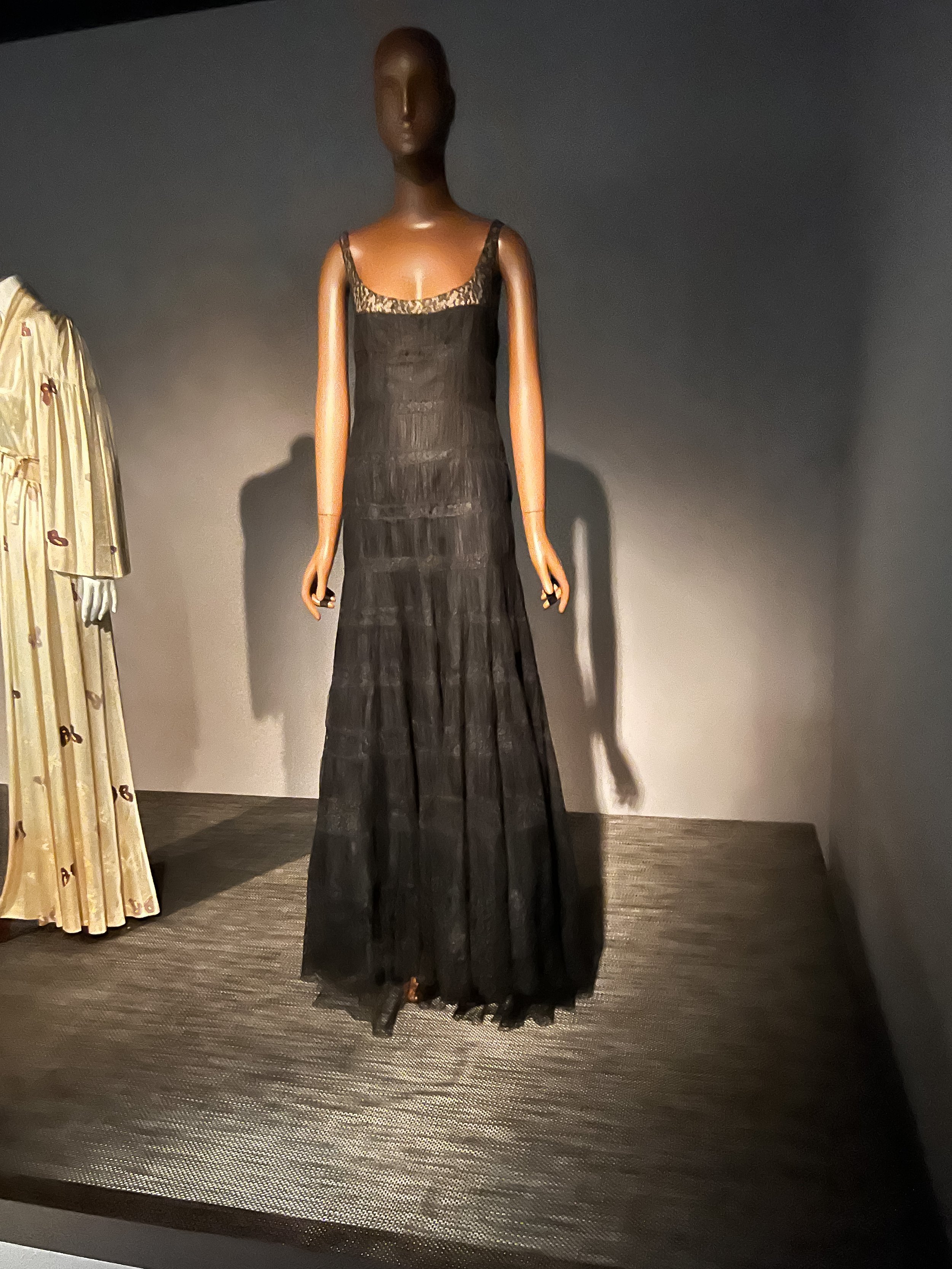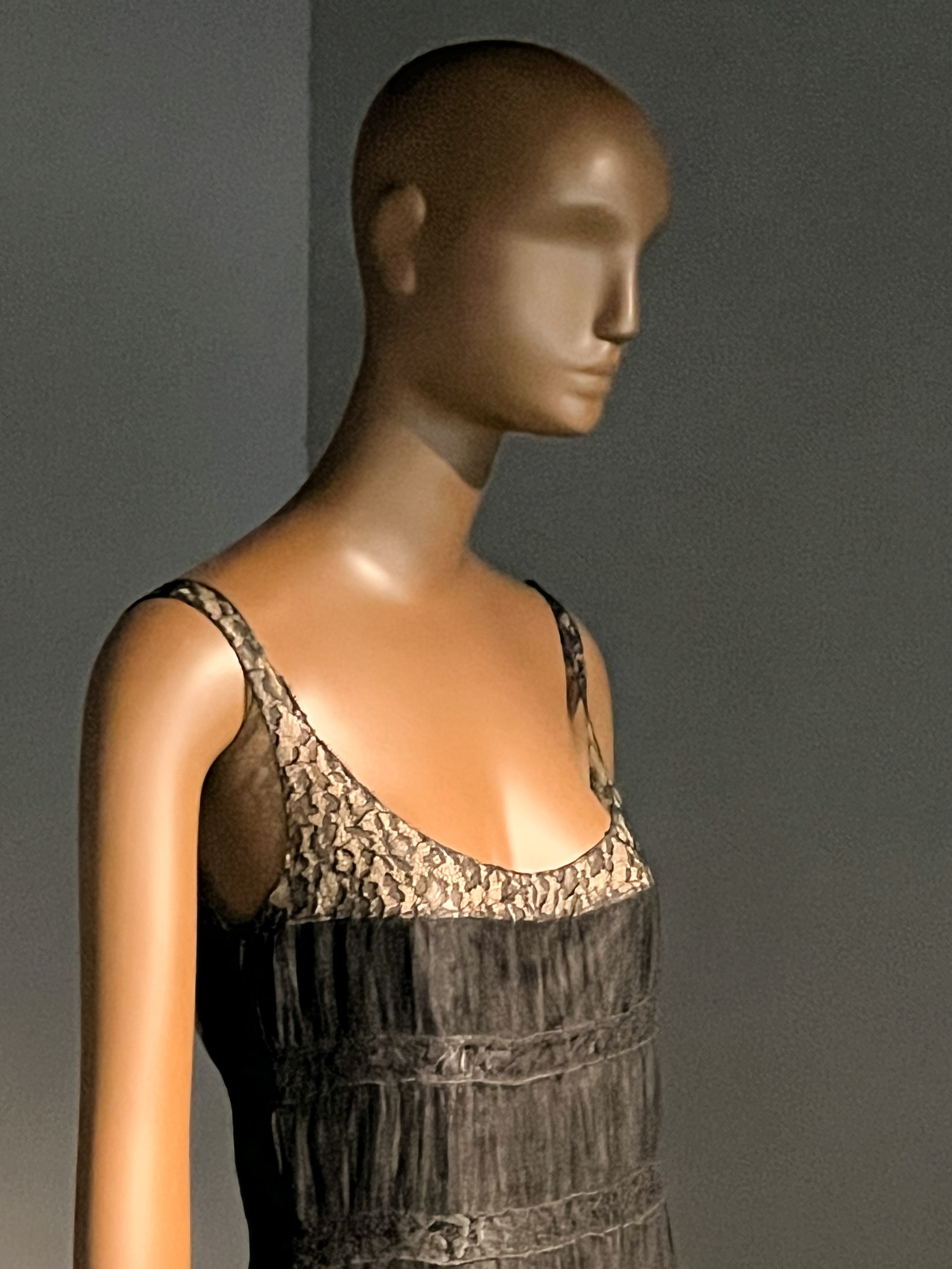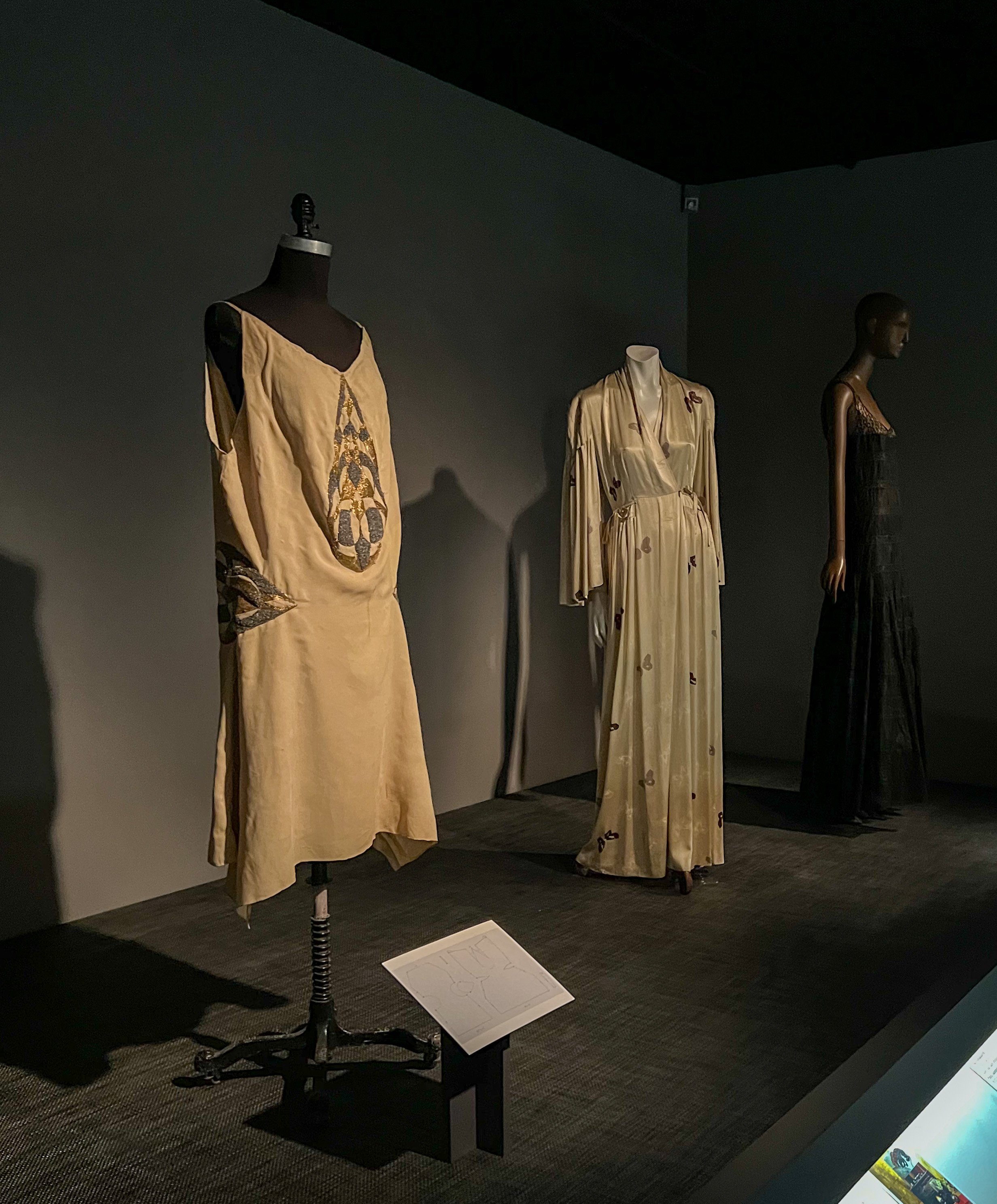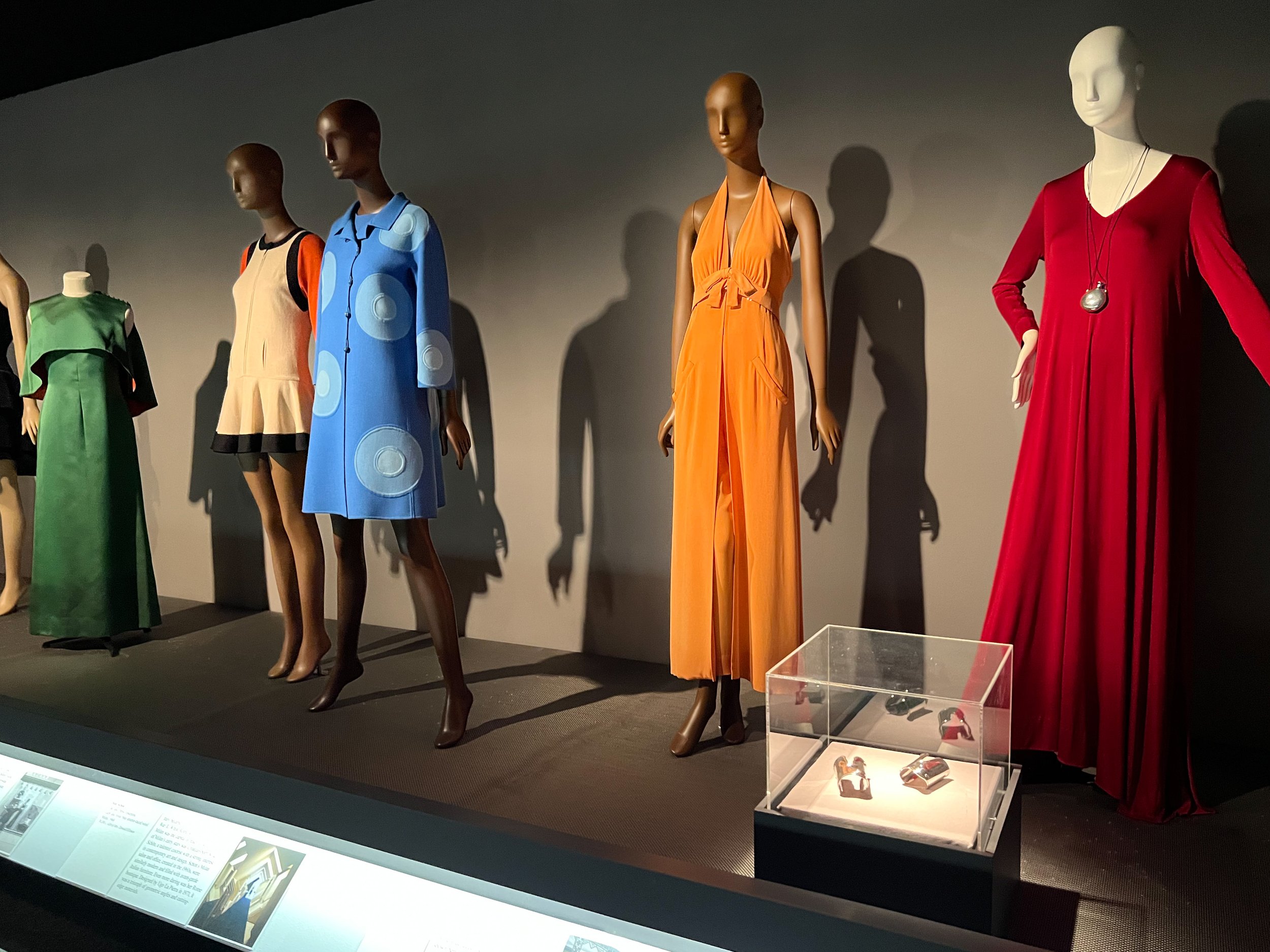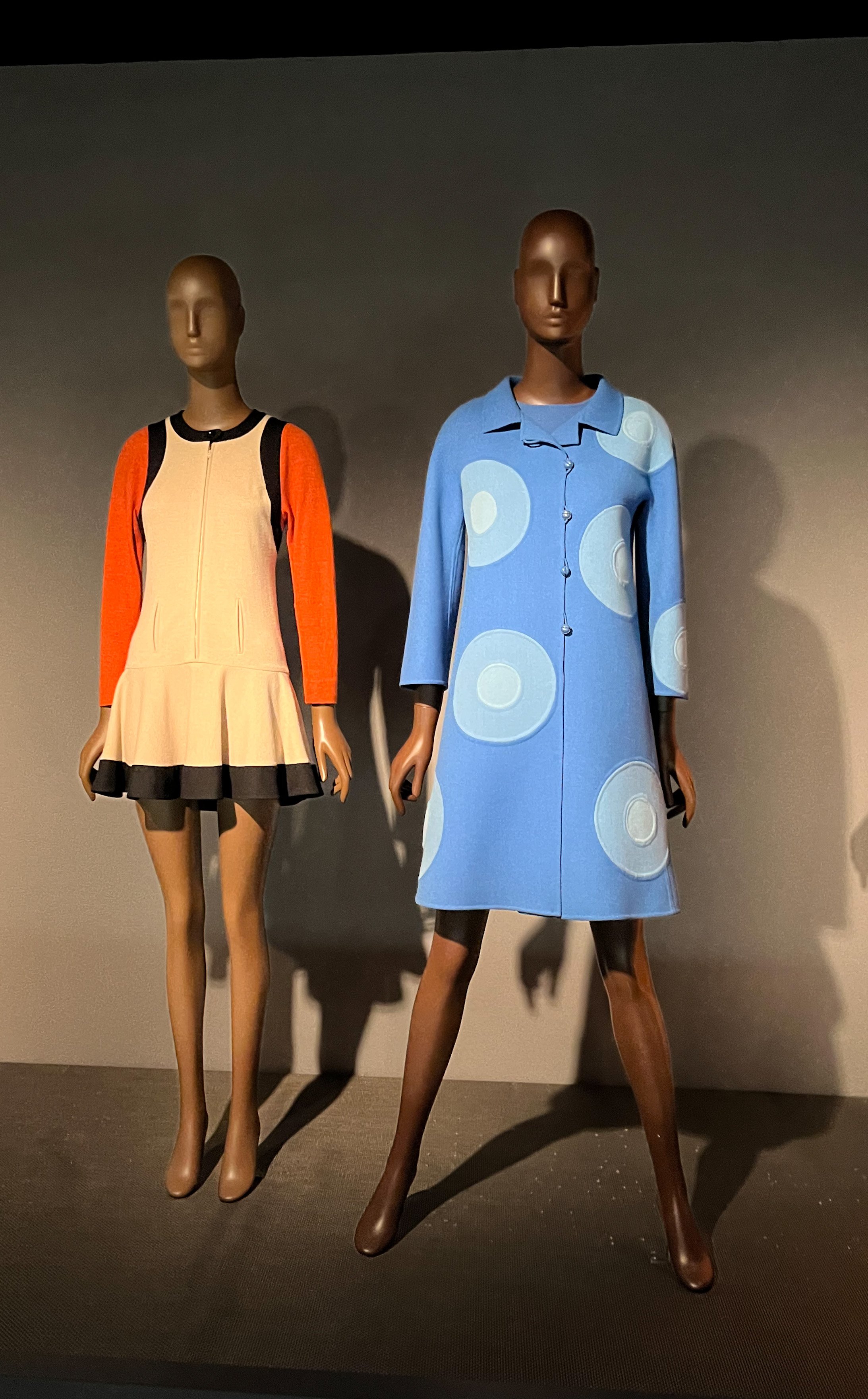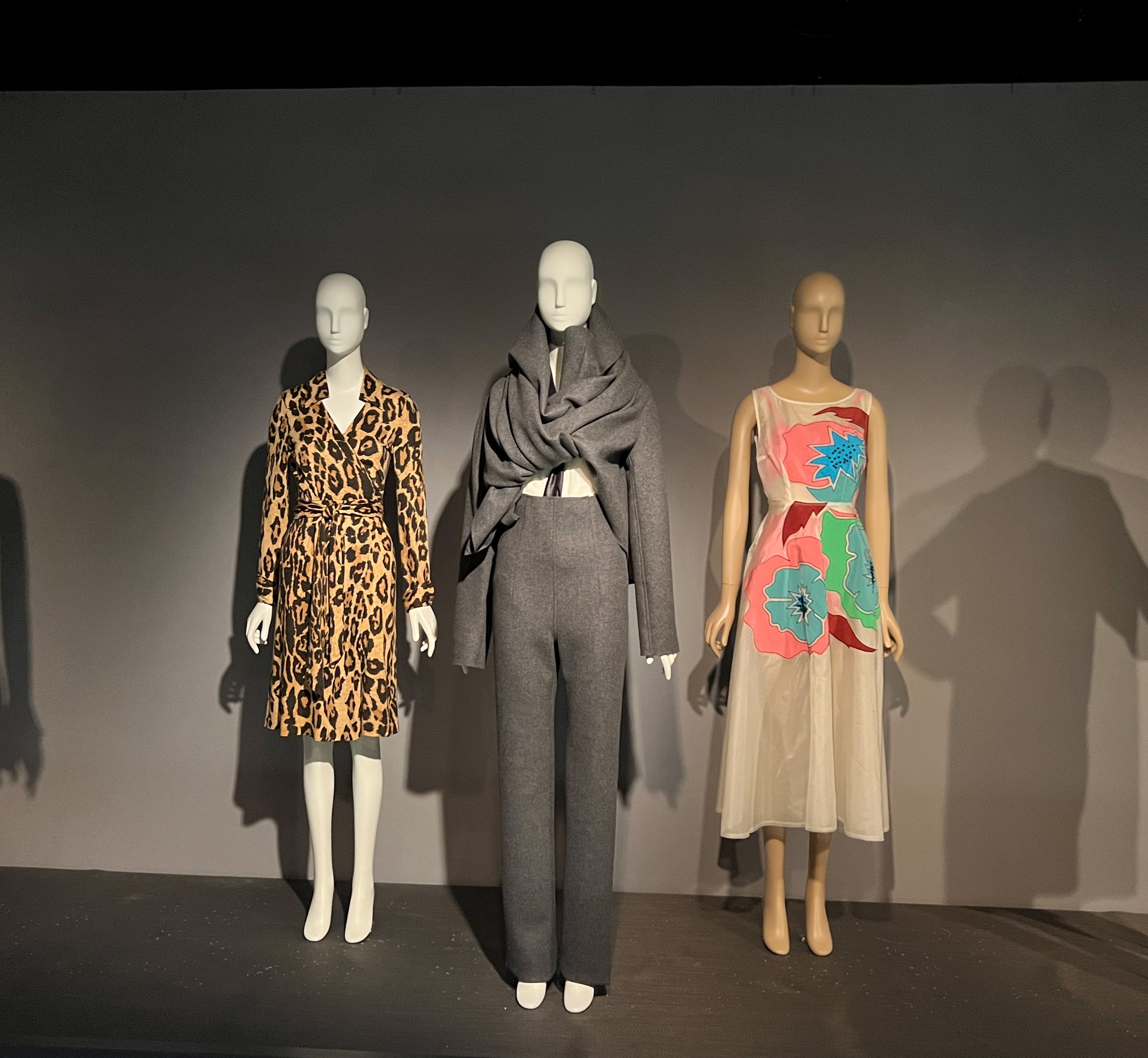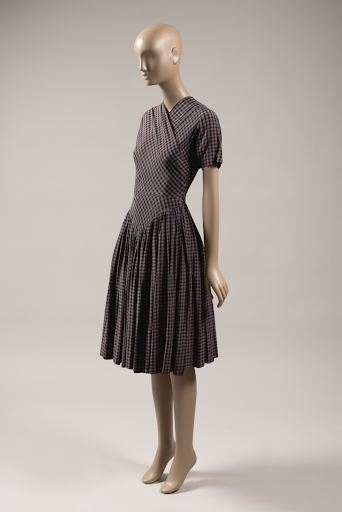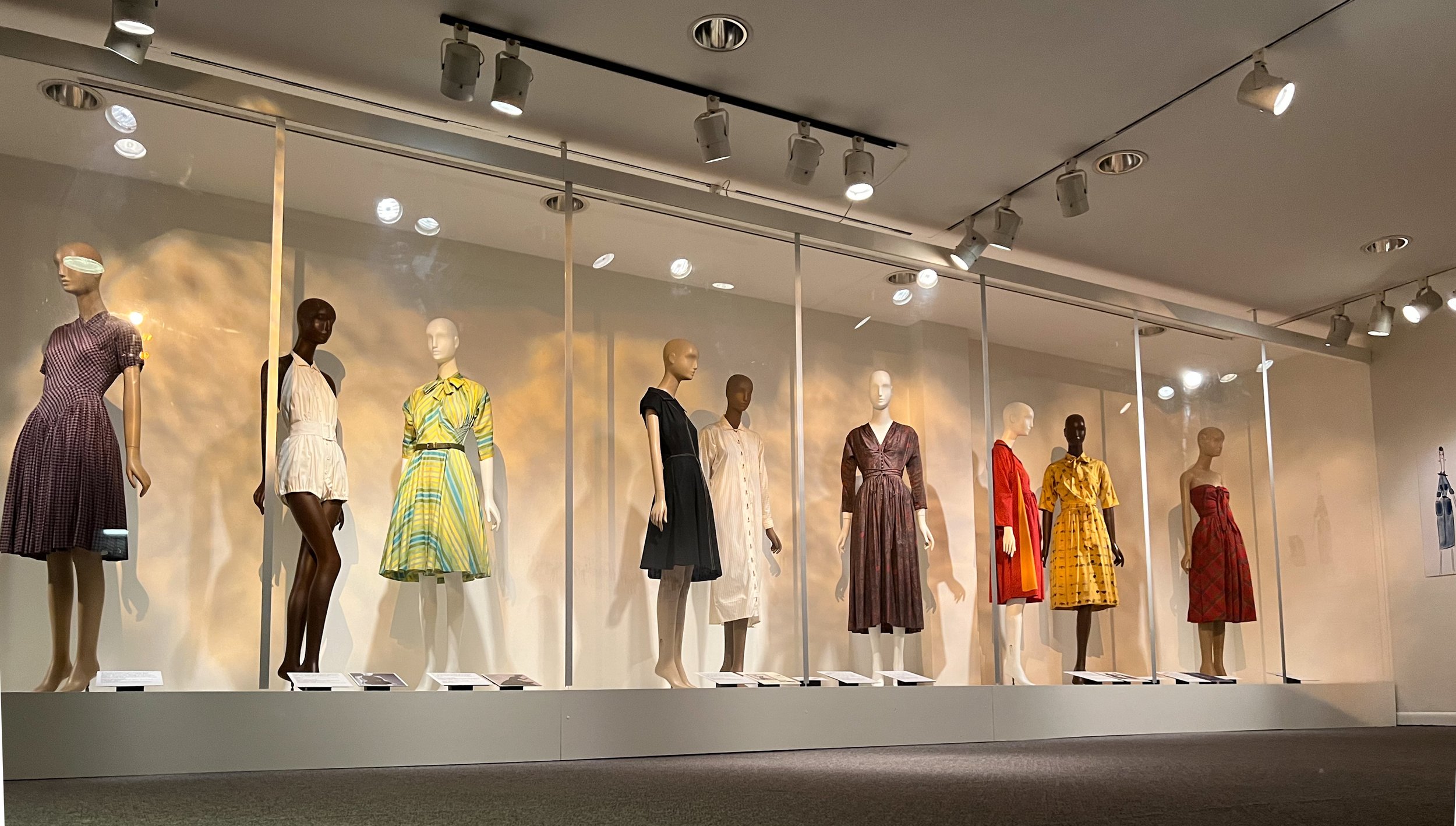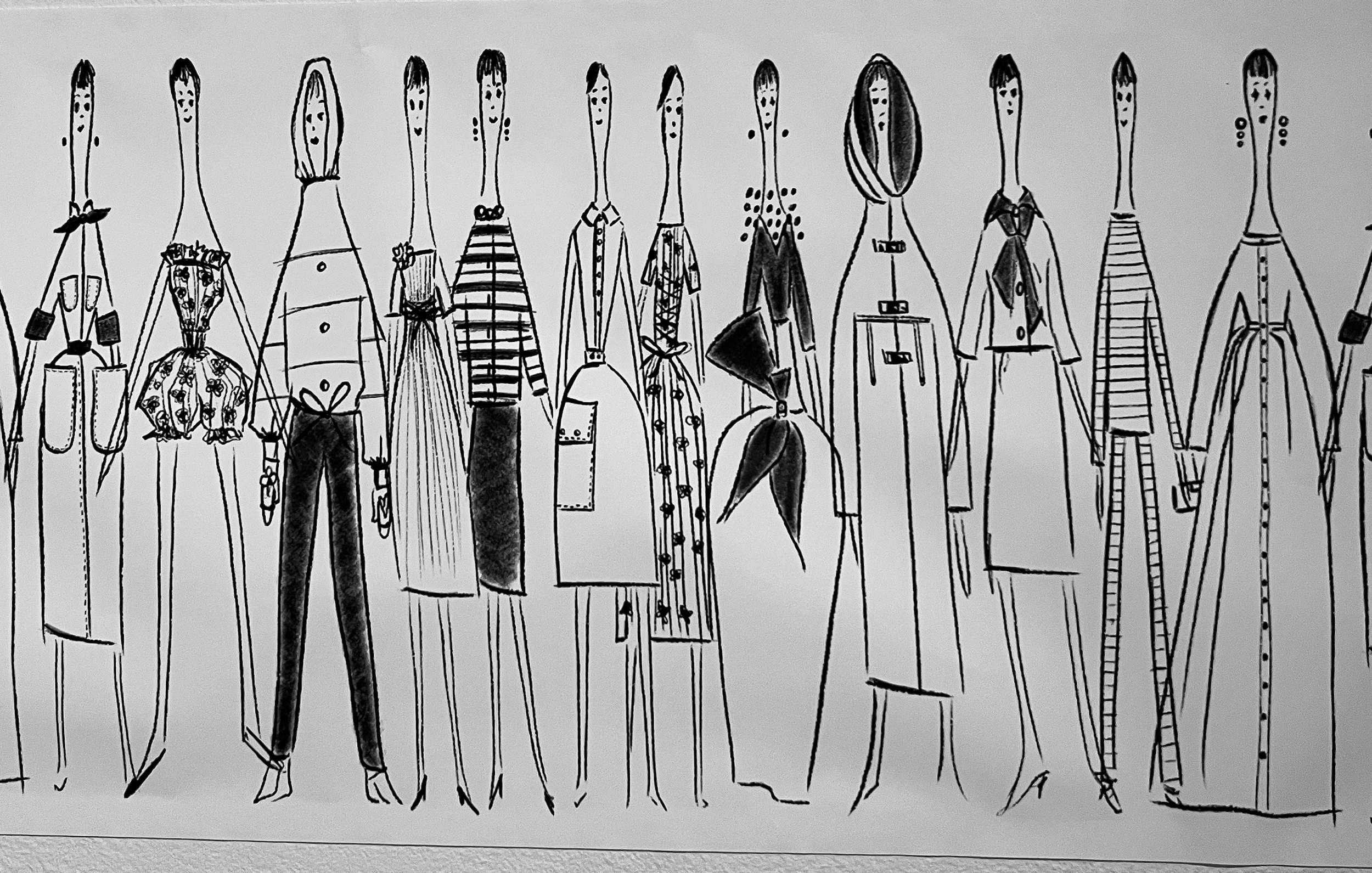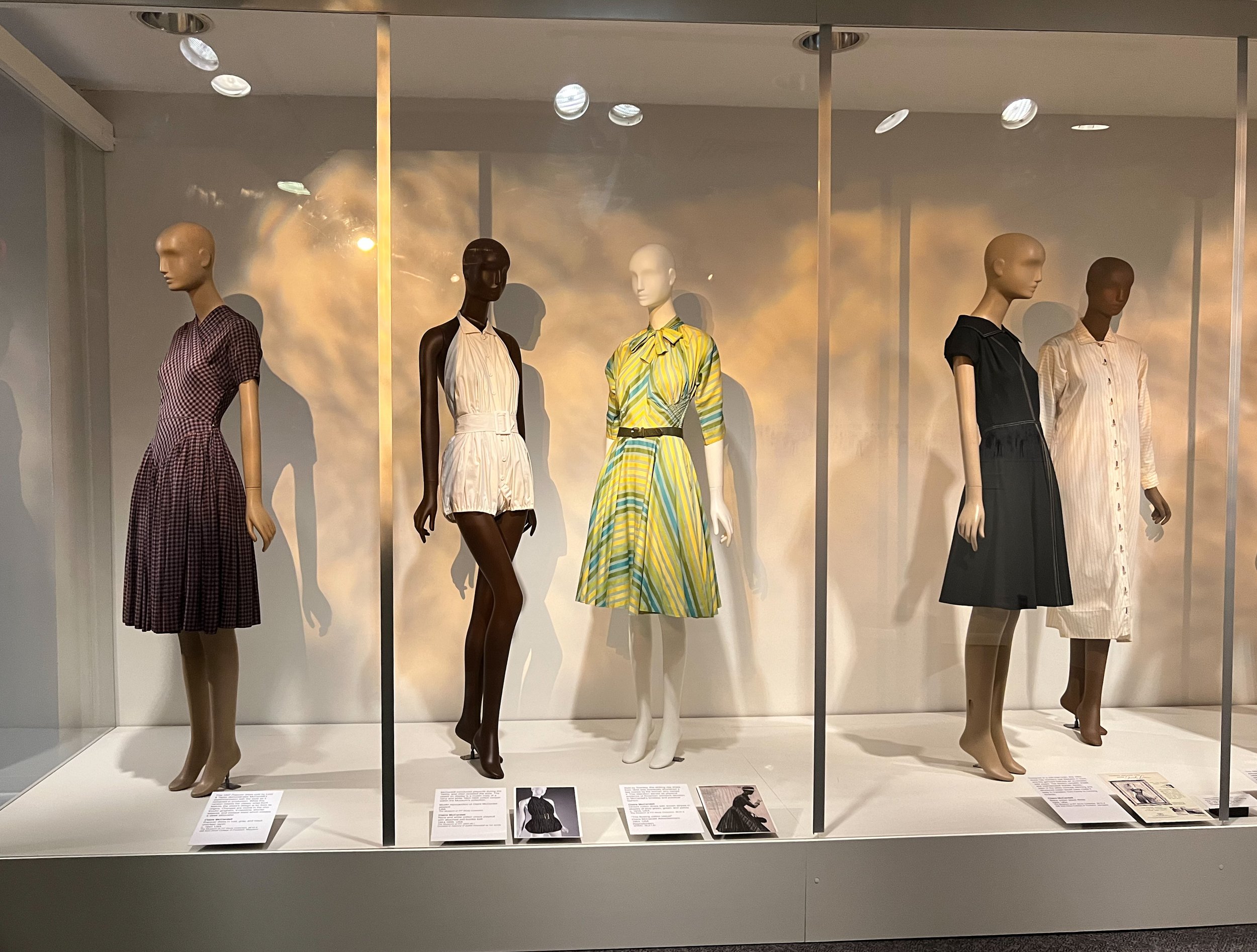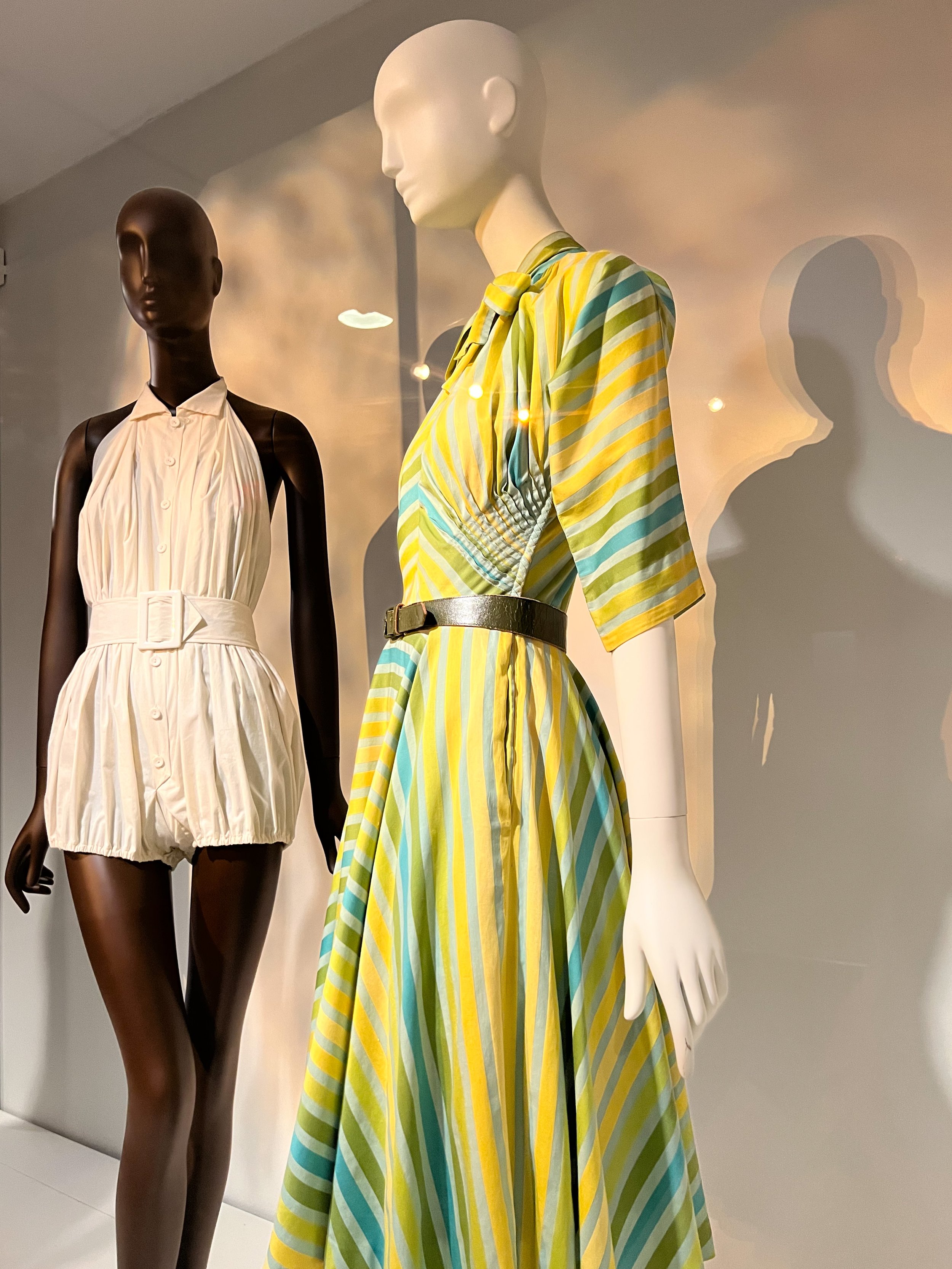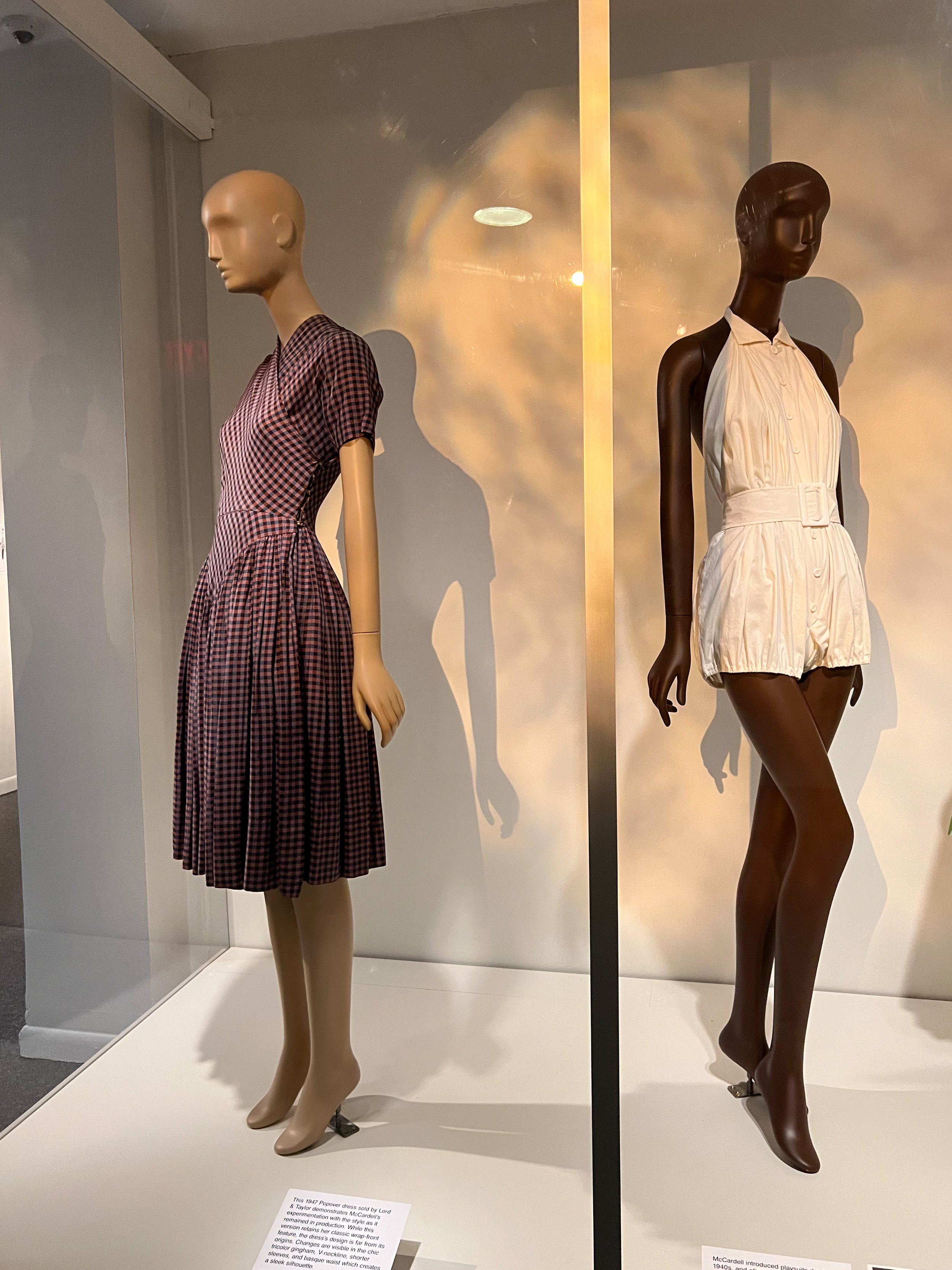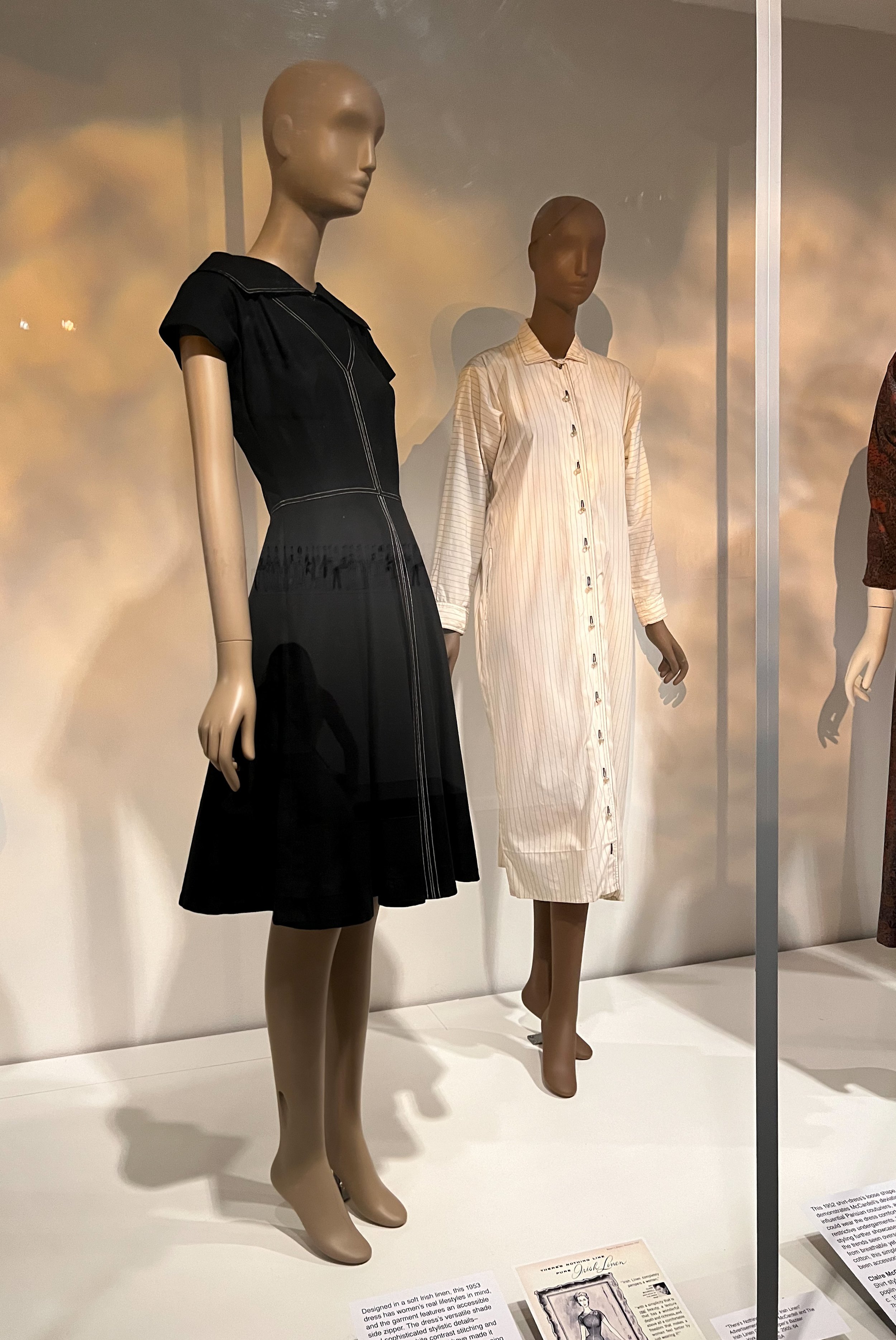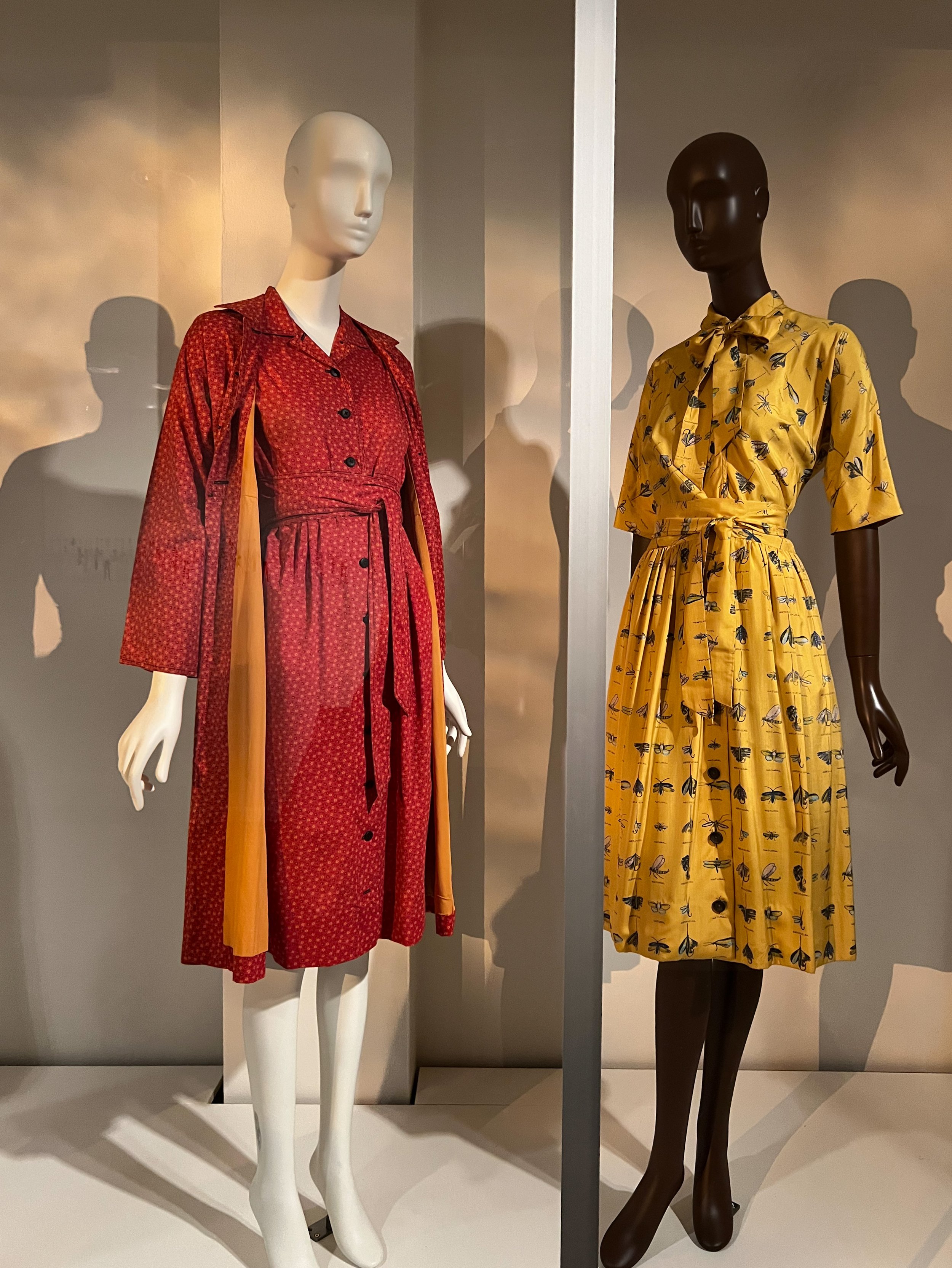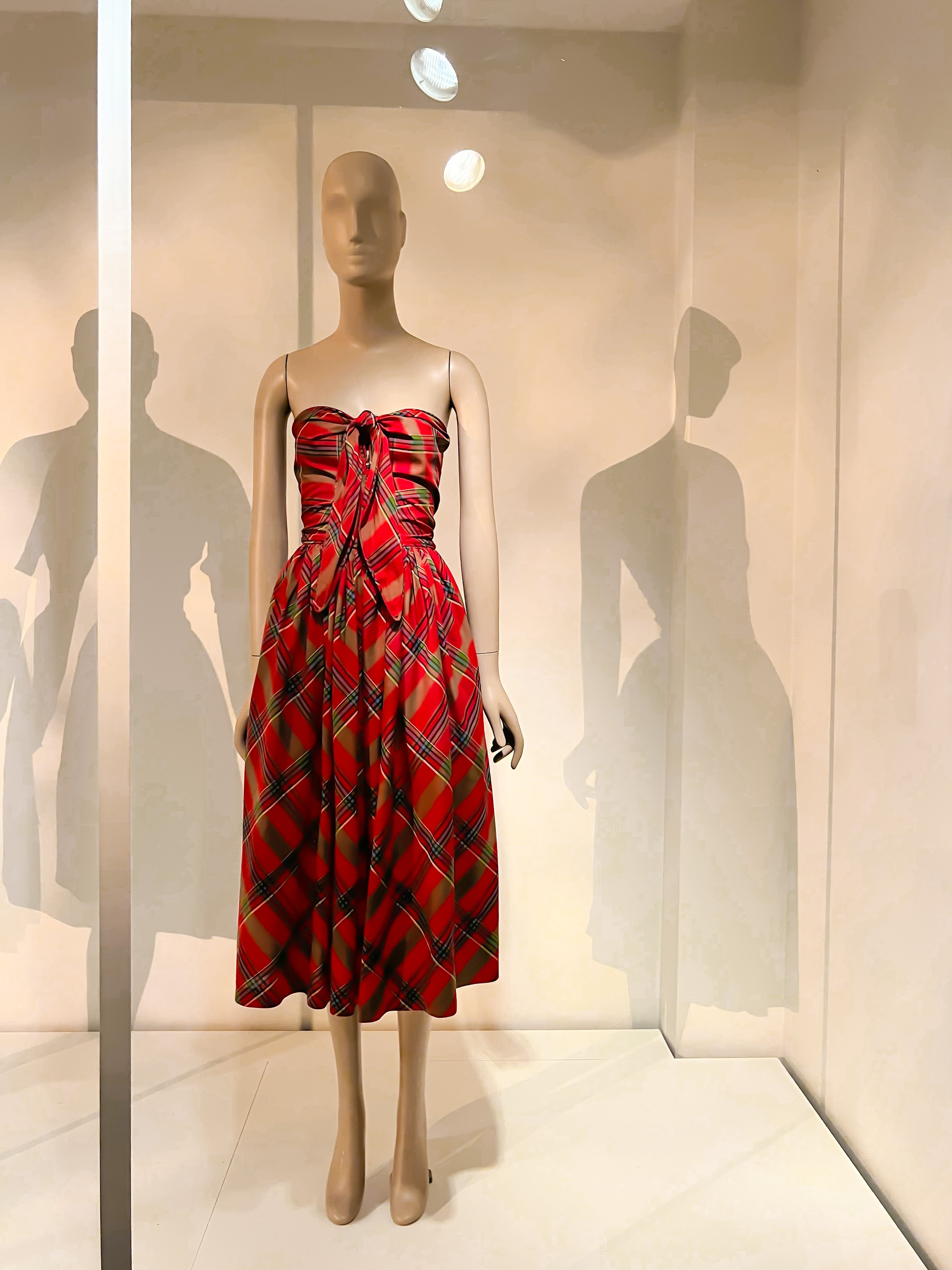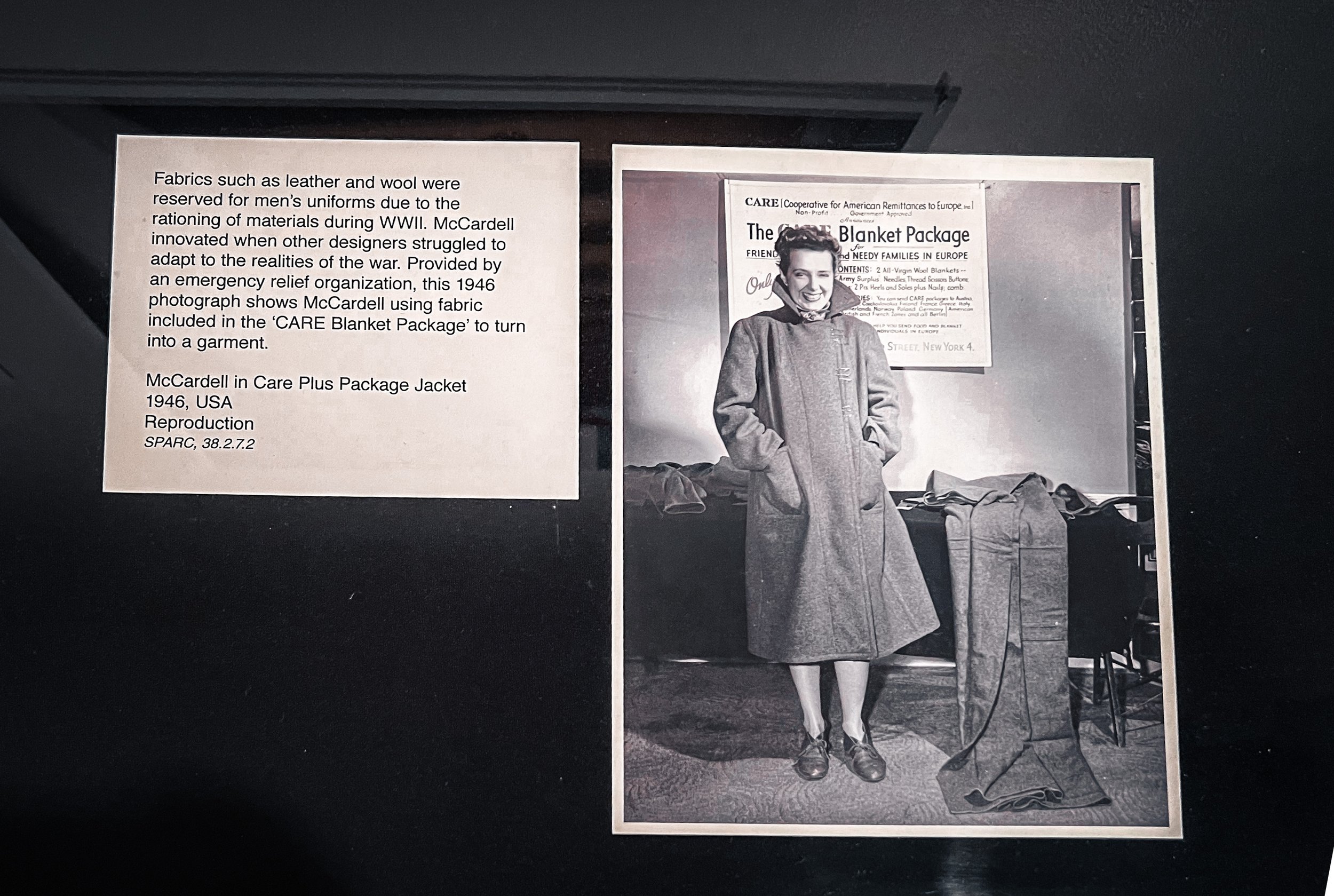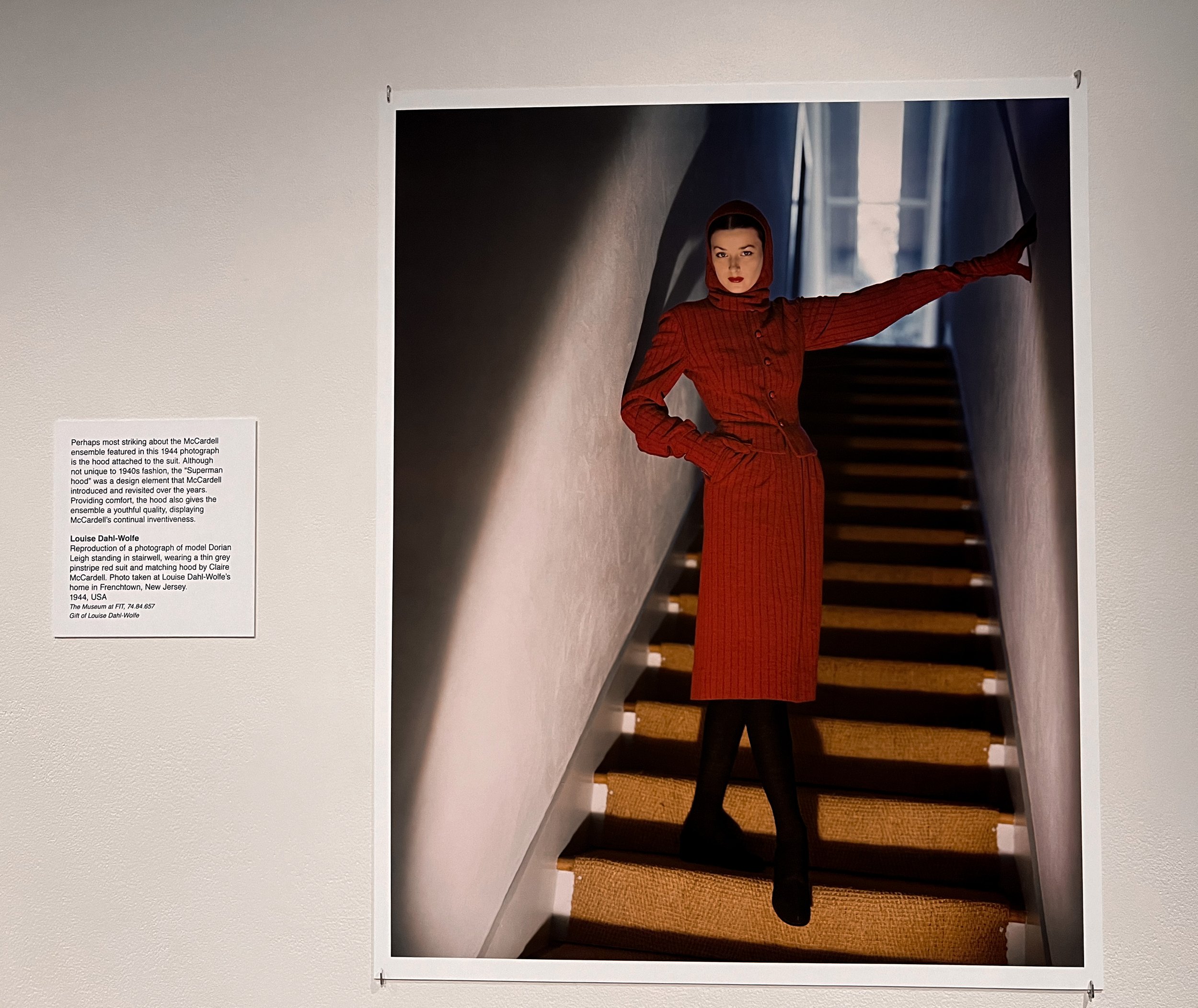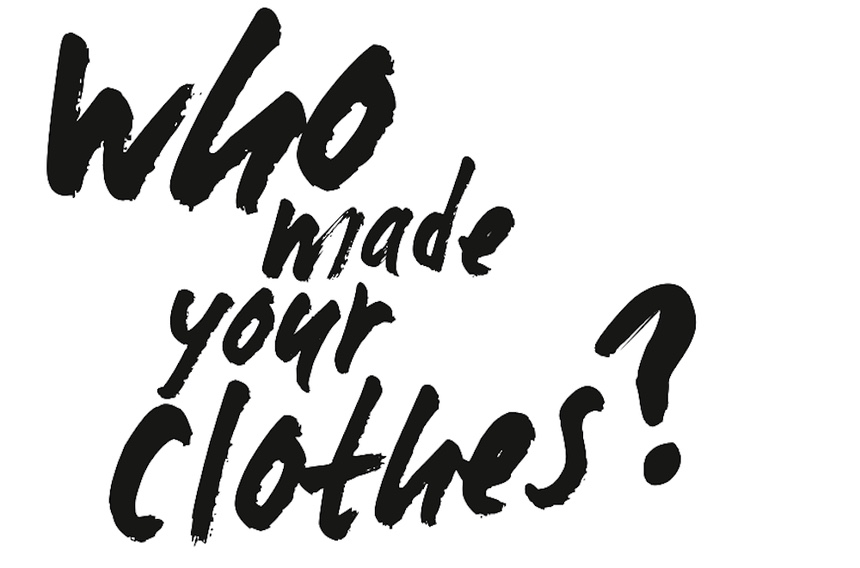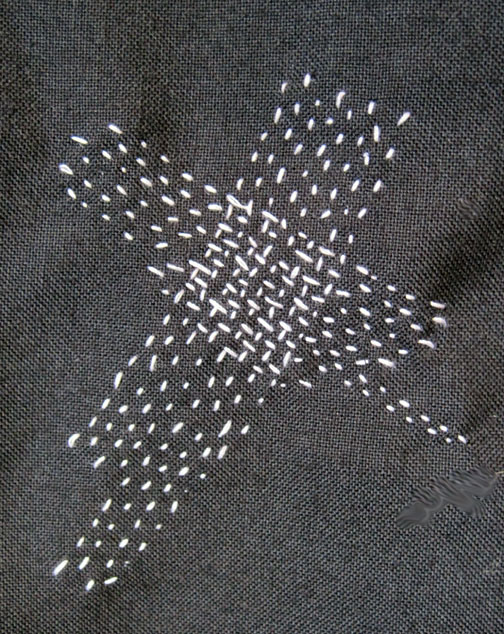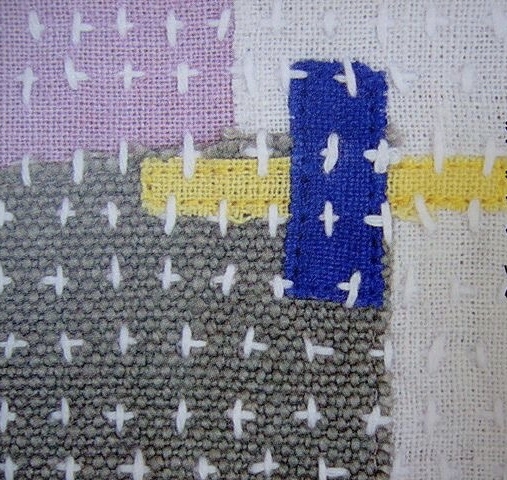Designing Women: Fashion Creators and Their Interiors
The recent exhibit at the Museum at FIT, Designing Women, Fashion Creators and their Interiors, beautifully captures the women behind the designs, her visions, her revolutions, her impact on the world and how her work influenced other women of their time– not in a prescriptive way, but rather by giving women new avenues for self-expression and empowerment. By pushing boundaries in both fashion and interior design, these designers expanded the realm of possibilities for women. By telling the story of the woman behind the designs, her visions, her revolutions, and her impact on the world – it shows how these women, through their work, transformed the spaces we live in and the clothes we wear.
Gowns attributed to Lucile, Lady Duff Gordon; at the Museum FIT exhibit: Designing Women: Fashion Creators and their Interiors
Designing Women: Fashion Creators and Their Interiors, a recent exhibit at the Museum at FIT, explores the interconnectedness of fashion and interior design through the lens of some of the most influential female designers of the 20th century. This exhibit was the second of five fashion exhibits that I saw while in NYC last month. Recently, I wrote about the student curated, Claire McCardell exhibit.
Fashion at its essence is a form of communication. Through it, we can express our identity, ideas, and aspirations. Since fashion reflects the cultural, political, and socio-economic context of a given period, this exhibit provides an opportunity to see how fashion influenced the creative process of some extraordinary twentieth-century fashion creators. While also inspiring a profound appreciation for the artistry and environmental influences that helped to shape their careers.
Gowns attributed to Lucile, Lady Duff Gordon and the Callot Sisters at the Museum FIT exhibit: Designing Women: Fashion Creators and their Interiors
Gowns by Jeanne Pauquin, at the Museum FIT exhibit: Designing Women: Fashion Creators and their Interiors
Understanding the Influence of 20th Century Women Designers
More than just a celebration of fashion, Designing Women, is an exploration of the creative process that reveals how fashion and design are used as a canvas to express views on femininity, comfort, luxury, and even rebellion. By challenging societal norms, the bold and pioneering clothing and interiors, redefined what fashion could be. Transforming not just the way women dressed, but also the way they lived.
You can see this duality in the work of Coco Chanel, for example. An icon of sophisticated simplicity, she prioritized comfort in her designs, while pioneering a new aesthetic of elegance that placed the modern woman at its core. Her Parisian apartment, with its neutral colors, exquisite minimalism, and mix of masculine and feminine elements, echoed the same philosophy. It portrayed luxury in the realm of comfort, serving as a physical extension of her avant-garde vision for women's fashion.
Coco Chanel, and Elsa Schaiparelli (right) at the Museum FIT exhibit: Designing Women: Fashion Creators and their Interiors
Detail Chanel Black Lace Evening Dress, C. 1932
Madeleine Vionnet, Schaiparelli, and Chanel dresses,
Chanel’s work was juxtaposed with designers such as Madeleine Vionnet, Jeanne Paquin, Elizabeth Hawes, Bonnie Cashin, Anna Sui, and Elsa Schiaparelli. Schiaparelli’s home, with its whimsical and provocative elements, was such a reflection of her Surrealist leanings. Underscoring how each woman's living space and their sartorial creations are truly an extension of their fashion ethos.
Placed within the broader historical context of the twentieth century, the curator, Deputy Director, Patricia Mears has skillfully incorporated the prevailing social, cultural, and artistic movements of the time, enabling visitors to better understand the designers' motivations, inspirations, and the impact their work had on society. This historical framework serves as a valuable backdrop, enhancing our appreciation for the transformative power of design and how it shaped the spaces we live in and the clothes we wear today.
As I meandered through the gallery, I could more fully appreciate how the personal philosophies of the designers became intrinsically woven into their work, and how their interiors were both a reflection and an extension of their personal styles. Not as separate spheres of private and public, fashion and interiors, but as a single canvas of personal expression for their revolutionary ideas. With each vignette, I looked for parallels and differences, for echoes and deviations. Remembering that each of these women was not only creating beautiful clothing, but also a new paradigm for women in their time.
Exploring Fashion and Interior Design
I often encourage my fashion students to go to museums and to look beyond the visual aesthetics and to think about the cultural, social, and historical context. To engage with the exhibition not just as an observer, but as a student of history and culture. Above all, I ask them to remember, every designer leaves a bit of herself in her work. Our job is to find and understand it.
Pauline Trigère, Mary Quant, Mila Schoën, Irene Galitzine, and Halston with Elsa Peretti “Bone” cuffs and “Bottle Open Bottle” Necklace.
Mary Quant and Mila Schön
Bonnie Cashin ensembles.
Gowns by Anouska Hemple and Carolyne Roehm.
Bonnie Cashin, Barbara Hulanicki for Biba, Diane von Furstenberg, Yeohlee, Tracy Reese, Anna Sui.
Diane von Furstenberg, Yeohlee, and Tracy Reese.
How Designing Women Transformed Fashion and Interior Design
Drawn from the Museum at FIT’s permanent collection, this exhibit beautifully captures the women behind the designs, her visions, her revolutions, her impact on the world and how her work influenced other women of their time– not in a prescriptive way, but rather by giving women new avenues for self-expression and empowerment. By pushing boundaries in both fashion and interior design, these designers expanded the realm of possibilities for women. By telling the story of the woman behind the designs, her visions, her revolutions, and her impact on the world – it shows how these women, through their work, transformed the spaces we live in and the clothes we wear.
I left with a renewed understanding of the transformative power of fashion, the significance of personal spaces, and the enduring legacies of these influential women. Designing Women is not only a celebration of their accomplishments but also a testament to the ongoing dialogue between fashion, art, and the spaces in which creativity flourishes. By highlighting these intertwined narratives, the exhibit encourages viewers to think more deeply about the cultural and historical contexts that these designers navigated, thus providing a comprehensive understanding of their contributions.
/\/\/\/\/\/\/\/\/\/\/\/
Hilarie
Designing Women: Fashion Creators and Their Interiors
At the Museum at FIT, November 30, 2022- May 14, 2023
Claire McCardell Exhibition at FIT: Exploring Fashion's Pioneer
In the world of fashion, certain designers leave an indelible mark on the industry, shaping trends and redefining the way we dress. One such visionary is Claire McCardell, whose groundbreaking designs continue to inspire and captivate fashion enthusiasts even today. In April, I was able to see a captivating exhibition celebrating the remarkable legacy of Claire McCardell, at the Museum at the Fashion Institute of Technology (FIT): Claire McCardell, Practicality Liberation, Innovation. This small exhibit showcased some of her revolutionary designs while highlighting her enduring influence on contemporary fashion.
Claire McCardell
Practicality, Liberation, Innovation
Claire McCardell, Popover dress, rayon, brass hooks & eyes, c. 1947, Lord & Taylor, American, founded 1826, Gift from Hood College of Frederick, Maryland, 96.61.6
In the world of fashion, certain designers leave an indelible mark on the industry, shaping trends and redefining the way we dress. One such visionary is Claire McCardell, whose groundbreaking designs continue to inspire and captivate fashion enthusiasts even today. In April, I was able to see a captivating exhibition celebrating the remarkable legacy of Claire McCardell, at the Museum at the Fashion Institute of Technology (FIT): Claire McCardell, Practicality Liberation, Innovation. This small exhibit showcased some of her revolutionary designs while highlighting her enduring influence on contemporary fashion.
As a lifelong McCardell fan, the is the second exhibit of her work that I have seen in six months. Before then, it had been about 30 years. Needless to say, I was thrilled.
A Pioneer in American Fashion:
Claire McCardell, born in 1905, emerged as a pivotal figure in American fashion during the mid-20th century. Known for her avant-garde approach to design, McCardell challenged conventional norms by prioritizing comfort, practicality, and freedom of movement in her garments. She played a significant role in shaping the modern concept of American sportswear, which emphasized simplicity, functionality, and wearability.
The exhibition was organized by four college seniors in the undergraduate program in Art History and Museum Professions (AHMP Program) at FIT. The garments showcased, are culled from the FIT Study Collection, with additional historical records from the Gladys Marcus Library’s Special Collection & College Archives.
Organized into three sections, Practicality Liberation and Innovation, this exhibit offers visitors a unique opportunity to witness the evolution of McCardell’s career and gain insights into her creative process. The curation captures McCardell's distinctive style, highlighting her groundbreaking use of fabric, innovative garment construction techniques, and keen eye for detail.
McCardell's designs were characterized by their clean lines, unstructured silhouettes, and inventive use of fabrics such as denim, menswear suiting woolens, and cotton. She introduced several innovative design elements that are now considered industry standards. For instance, the use of unique closures, such as grommets and hooks and eyes, spaghetti string ties and well-proportioned pockets are all McCardell-isms. The ballet flat as a shoe style, now a staple in every woman's wardrobe, can be traced back to McCardell's ingenious creations. She also popularized the concept of mix-and-match separates, allowing women to effortlessly combine different pieces to create versatile outfits.
Challenging Norms and Promoting Individuality: McCardell's designs not only prioritized comfort and practicality but also challenged societal norms, encouraging individuality and self-expression. She designed clothing that catered to the changing needs of women, both in domestic and public spheres, and even adhered to war rationing guidelines. By liberating women from cumbersome and restrictive clothing, McCardell truly transformed the fashion landscape. Her emphasis on functionality and ease of wear continues to resonate with modern designers, ensuring her lasting influence.
Below is a gallery of images of the garments.
Beyond showcasing McCardell's designs, the exhibition walls and tables were lined with reproductions of photographs as well as advertisements, flyers, newspaper clippings and letters to place the social and cultural context in which her work emerged. Visitors were encouraged to contemplate the impact of World War II on fashion and witness how McCardell's designs responded to the era's challenges, embracing a sense of optimism and liberation.
Claire McCardell's trailblazing designs serve as a source of inspiration for students, designers and enthusiasts alike. Her ability to bridge the gap between high fashion and practicality continues to influence contemporary fashion, encouraging the exploration of innovative techniques and the creation of garments that empower individuals to express their unique style.
The Claire McCardell exhibition at the Museum at FIT is a testament to the enduring legacy of this remarkable designer. Her contributions to American fashion, her innovative design philosophy, and her unwavering commitment to creating comfortable yet stylish clothing continue to inspire and captivate fashion enthusiasts and designers alike. Exploring the exhibition provides a glimpse into McCardell's revolutionary designs and the profound impact she had on shaping the fashion industry. Claire McCardell's remarkable vision serves as a reminder that fashion can transcend trends and that timeless design can continue to shape and influence the way we dress for generations to come.
/\/\/\/\/\/\/\/\/\/\/\/
Hilarie
To see more photos, follow the hashtag on social media. #clairemccardellMFIT
10 Children's Books About Fashion and Sewing that Feature Black Characters
In recent years, I have found an increase in the number of books that are both fashion and sewing related that feature kids with black and brown skin. This expanded diversity not only allows kids the opportunity to see themselves in these stories but also helps broaden the perspective of all children by fostering their sense of empathy and connection with characters who might look different from themselves.
Children love seeing faces like theirs within the pages of their books. For many years it was often challenging to find books starring kids of color, Ezra Jack Keats comes to mind, but few others. In recent years, I have found an increase in the number of books that are both fashion and sewing related that feature kids with black and brown skin. This expanded diversity not only allows kids the opportunity to see themselves in these stories but also helps broaden the perspective of all children by fostering their sense of empathy and connection with characters who might look different from themselves.
To help you discover a few new titles perfect for reading with your kids, I’m sharing a few of my favorite books for elementary school readers. Whether they're sewing quilts or navigating friendships, designing gowns or standing their ground, these characters exude confidence, happiness — and individuality.
Elementary School Readers
Fancy Party Gowns, Blumenthal, A Story about Ann Cole Lowe
Mary Had a Little Glam, Sauer
I had a Favorite Dress, Ashburn
I had a Favorite Hat, Ashburn
Stitchin’ and Pullin’: A Gee’s Bend Quilt, Patricia McKissack
Mary Wears What She Wants, Negley
Tar Beach , Faith Ringold
Later Elementary and Middle School Readers
Mrs. Lincoln’s Dressmaker, Lynda Jones The story of Elizabeth Keckley
How to be a Fashion Designer, Leslie Ware
Sew Fab, Leslie Ware
Form, Function and Culture
In Pattern Making, there are three types of sleeves; set-in, raglan and kimono. All other sleeve styles are developed from one of these three blocks.
However, in this era of globalization, it no longer feels correct to refer to this as a “kimono sleeve”. What then, is an appropriate name for a bodice where the sleeve is integrated into the design instead of a separate piece? “T-shape? Extended sleeve? Robe?
In Pattern Making, there are three basic types of sleeves; set-in, raglan and kimono. All other sleeve styles are developed from one of these three blocks.
However, in this era of globalization, it no longer feels correct to refer to a style as a “kimono sleeve”. What then, is an appropriate name for a bodice where the sleeve is integrated into the design instead of a separate piece? “T-shape? Extended sleeve? Robe?
I have been giving a lot of thought to the intersection of cultural appropriation, pattern making and fashion. Currently, I am working on a new pattern, one that is loose fitting and has a kimono-style sleeve. But I am at a loss of how to describe it. This simple shape, once cut and constructed, no longer looks like the rectangle that is was essentially developed from. The straight grain of the fabric will run up and down the body, and the cross grain across the shoulders. Different than batwing, not dolman, not tunic.
A respectful interpretation of the world’s cultures can allow all cultures to mutually enrich themselves and bring about genuine benefits to society. A diversity of cultural influences is what makes fashion, like art and music evolve and thrive. Additionally, as a sewing and fashion educator, I have a classroom of kids that come from all manner of background and identity. They look to me to guide them and to set an example. To foster a truly global society, it is imperative to teach inclusivity, appreciation and respect. If these students leave my class, and future fashion studies unversed, then we as educators are part of the problem.
Traditional clothing is not simply functional or ornamental. It is infused with meaning and is woven into the very identity of a people, geographic area or a period in history. That is why designing clothing without consideration for the underlying cultural significance can lead to ignorance of the history of entire communities For a much more eloquent and thoughtful explanation, read this post, My Kimono is Not Your Couture, by Emi Oto.
So what is appropriate and respectful? Is it enough to describe the top as having a “kimono sleeve”, but then include a sentence that invites conversation and states that that is the technical name of the sleeve type? Could it be described as having a kimono style influence- even though it bears little resemblance to an actual kimono? If we go forward and “ignore” traditional influences, we lose the opportunity to learn and appreciate. The preservation of culture and cultural diversity gives voice to each and every person in this global community and can affect real and lasting change.
With that sentiment, I am asking you, my readers and friends, to please share your thoughts with me. How do you recognize and appreciate global fashion while still being intentional and sensitive? What do you make of “technical” terms that have no clear replacement? I do look forward to your comments.
An.thro.po.cene
On April 24, 2013, the Rana Plaza collapse killed over 1,100 garment workers in Bangladesh and wounded over 2,200 more. The incident left consumers all over the world questioning who makes the clothes we wear everyday and in what kind of conditions?
An·thro·po·cene
/ˈanTHrəpəˌsēn/
adjective
relating to or denoting the current geological age, viewed as the period during which human activity has been the dominant influence on climate and the environment.
"we've become a major force of nature in this new Anthropocene epoch"
noun
the current geological age, viewed as the period during which human activity has been the dominant influence on climate and the environment.
"some geologists argue that the Anthropocene began with the Industrial Revolution"
*Cited from dictionary.com
On April 24, 2013, the Rana Plaza collapse killed over 1,100 garment workers in Bangladesh and wounded over 2,200 more. The incident left consumers all over the world questioning who makes the clothes we wear everyday and in what kind of conditions?
Documentaries like The True Cost (If you haven’t watched it yet, it is free to view on Netflix.) shine a light on how the fast fashion industry depletes the earth’s resources and leverages slave labor to pass on a cheap cost to the end consumer. We live in a time where clothing is disposable and often costs less than a meal. How can something that needs to be grown, harvested, spun, woven, cut, stitched, labeled, packaged and shipped cost a couple of dollars? Fashion and the textile industry at large are tied to many other aspects of life, including culture, politics, agriculture and the environment. Through our shopping choices we can collectively influence how our clothes are sourced, produced, distributed, and as a result change the world in a real and meaningful way.
Historically, people learned to sew in order to make their clothing and home textiles. After the Industrial Revolution, when ready made clothing was available, it still needed to be kept up, altered and repaired. And, it was expensive. Sewing was then a means to recreate designer looks in a more affordable way.
As someone who loves fashion, the collapse of the Rana Plaza factory really got my attention. Since then, I have become much more aware of the impact of my decisions can have on the world at large. Getting started was tough! Not every brand is transparent in their sourcing and production. Making every item isn’t an option either. It is too easy to get stuck comparing choices or to just “opt out”. The truth is, there really isn’t a perfect choice. The most sustainable clothing is that which we already own. That being said, if you would like to see how your favorite brands rank, check the Fashion Transparency Index.
The easiest change that we can make to reduce our impact is to buy less and properly care for what we already own. Instead of buying new, consider vintage and pre-owned, rent or even swap with friends! I know all easier said than done, right? But consider doing just one thing differently. Right now, the average garment is worn seven times before it is discarded. Seven times. Imagine if we were to double that number and wear each clothing item 14 times? Radical, right?
When I was growing up, there used to be something called, “Cost per wear”. I have no idea where I learned it, but it was a fairly common concept. You check the price of the item, consider how many other things you already have to go with it, and try to imagine the number of times you will wear the garment. For example, say I bought a top for $80. If I wear that 7 times, it costs me $11.42 cents each time I wear it. A sweater for $100, $14.28. You get the point. Now, what if I only chose to purchase items that I really, really loved and took exceptional care of them. The cost per wear goes down exceptionally. Perhaps that sweater might last a decade or two and only cost me pennies per wear. Think about this next time you shop.
As conscious consumers, it’s more important than ever to educate ourselves. Nobody invented a magical, cheaper way to make clothing, and fabric didn’t drop in price. We just began exploiting developing countries and caring less about the damage along the way. By asking #WhoMadeMyClothes, demanding transparency, and vocalizing our objections we make a positive difference for the people making our clothes and goods. Real change can start with us.
This week, follow me on Instagram with the hashtag #whomademyclothes and #LovedClothesLast and check back here to learn more about how to take fashion into your own hands and to give a kind of noblesse oblige to your wardrobe.
XOXO, Hilarie
Make Do and Mend
Would it surprise you to learn that the average piece of clothing is worn only 7 times before it is discarded? Seven times. When I was younger, and considering wether a purchase was “worth it”, I would calculate the Cost Per Wear- and use that number to decide how much to spend on an item of clothing. If I knew that I would only wear something 7 times, it would hardly be worth spending much on. Now a coat, sweater or dress that might be worn a few times a year for many years would be a different story. I have one grey cashmere cardigan that is fairly tattered by now, but it has been in constant seasonal rotation for twenty years. It might have cost me $100 back then, but overtime, just pennies per wear. A new pair of jeans might cost even more than that- but what if they are only worn for a single season? Do you understand my point?
Would it surprise you to learn that the average piece of clothing is worn only 7 times before it is discarded? Seven times. When I was younger, and considering wether a purchase was “worth it”, I would calculate the Cost Per Wear- and use that number to decide how much to spend on an item of clothing. If I knew that I would only wear something 7 times, it would hardly be worth spending much on. Now a coat, sweater or dress that might be worn a few times a year for many years would be a different story. I have one grey cashmere cardigan that is fairly tattered by now, but it has been in constant seasonal rotation for twenty years. It might have cost me $100 back then, but overtime, just pennies per wear. A new pair of jeans might cost even more than that- but what if they are only worn for a single season? Do you understand my point?
During World War II, the Make Do And Mend campaign was Vogue's call to women to alter, change, patch or re-do clothing rather than wasting precious resources. It encouraged homemakers to be resourceful and thrifty. Handmade and hand-repaired clothing became an essential part of wartime life. People got creative across the country out of necessity, finding ways to make and care for clothes - and forge their own wartime style. At that time, more people knew how to sew and how to repair their own clothes.
Growing up, clothing was a luxury. I am the oldest of 10 children- fortunately (since I do love clothes) I learned to sew at a very young age. I spent many years practicing on thrift store bargains and hand me downs. Through necessity, an article of clothing could live many lives before finally hitting the scrap bin. This experience has greatly informed my style and point of view.
Sustainability is a key buzz word in the world of fashion and textiles these days. With good reason! Next to fossil fuels, the fashion industry is the worlds biggest environmental offender. But it doesn’t have to be. We can disrupt the cycle. Buy less, care for what you have, swap with a friend, learn to mend! I promise you won’t regret it!
If you want a stylish way to begin this journey, look no farther! I am having a Visible Mending Workshop for teens and adults on November 10.
Last year’s sweatshirt is this year’s prized top!
Visible mending.
Visible mending on patchwork. Look for this in my shop soon- I just need to remember to frame it:)

